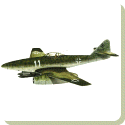 Messerschmitt Me 262A — The Messerschmitt Me 262 Schwalbe (“Swallow”) was the world’s first operational jet powered fighter aircraft. Design work started before World War II began, but engine problems prevented the aircraft from attaining operational status with the Luftwaffe until mid-1944. Compared with Allied fighters of its day, including the jet powered Gloster Meteor, it was much faster and better armed.
Messerschmitt Me 262A — The Messerschmitt Me 262 Schwalbe (“Swallow”) was the world’s first operational jet powered fighter aircraft. Design work started before World War II began, but engine problems prevented the aircraft from attaining operational status with the Luftwaffe until mid-1944. Compared with Allied fighters of its day, including the jet powered Gloster Meteor, it was much faster and better armed.
In combat, when properly flown, it proved difficult to counter due to its speed. Me 262 pilots claimed a total of 542 Allied kills (although higher claims are sometimes made) against the loss of about 100 Me 262s. The design was pressed into a variety of roles, including light bomber, reconnaissance and even experimental night fighter versions.
The Me 262 was one of the most advanced aviation designs in operational use during World War II. The Allies countered its potential effectiveness in the air by relentlessly attacking the aircraft on the ground, or while they were taking off or landing. Maintenance problems and a lack of fuel during the deteriorating late-war situation also reduced the effectiveness of the aircraft as a fighting force. In the end, the Me 262 had a negligible impact on the course of the war due to its late introduction and the small numbers that were deployed in operational service.
The Me 262 influenced the designs of post war aircraft such as the North American F-86 Sabre and Boeing B-47 Stratojet.
Design and Development
Although often viewed as a last-ditch superweapon, the Me 262 was already being developed as project P.1065 before the start of World War II. Plans were first drawn up in April 1939, and the original design was very similar to the plane that would eventually enter service. The progression of the original design into service was delayed by a lack of funds, as many high-ranking officials thought that the war could easily be won with conventional aircraft, and therefore most of the available government funds were used for the production of other aircraft.
The aircraft was originally designed with a tail wheel undercarriage and the first four prototypes (Me 262 V1-V4) were built with this configuration, but it was discovered on an early test run that the engines and wings “blanked” the stabilizers, giving almost no control on the ground. Changing to a tricycle undercarriage arrangement, initially as a fixed undercarriage on the fifth prototype aircraft, then a fully retractable one on the sixth and succeeding prototypes, immediately corrected all of these problems.
Although it is often stated that the Me 262 is a “swept wing” design, the production Me 262 had a leading edge sweep of only 18.5°. This was done primarily to properly position the center of lift relative to the centre of mass and not for the aerodynamic benefit of increasing the critical Mach number of the wing. The sweep was in fact too slight to achieve any significant advantage.This happened after the initial design of the aircraft, when the engines proved to be heavier than originally expected. Instead of moving the engines rearward on their mounts, the whole wing was bent slightly backwards to the same end.
The first test flights began in April 1941, but since the BMW 003 turbojets were not ready for fitting, a conventional Junkers Jumo 210 engine was mounted in the nose, driving a propeller, to test the Me 262 V1 airframe. When the BMW 003 engines were finally installed the Jumo was retained for safety which proved wise as both 003s failed during the first flight and the pilot had to land using the nose mounted engine alone.
The V3 third prototype airframe became a true “jet” when it flew on 18 July 1942 in Leipheim near Günzburg, Germany, piloted by Fritz Wendel. This was almost nine full months ahead of the British Gloster Meteor’s first flight on 5 March 1943. The 003 engines, which were proving unreliable, were replaced by the newly available Junkers Jumo 004. Test flights continued over the next year but the engines continued to be unreliable. The overall development of the aircraft was slowed greatly due to problems with the new engines. An edict by Adolf Hitler, that the Me 262 also perform in a bomber role, is often cited as an additional major development delay. It is likely this added only slightly to the period required to bring the Swallow to production.Airframe modifications were complete by 1942, but hampered by the lack of engines, serial production did not begin until 1944. This delay in engine availability was in part due to the shortage of strategic materials, especially metals and alloys that could handle the extreme temperatures produced by the jet engine. Even when the engines were completed they had an expected operational lifetime of approximately 50 hours, however in the real world most 004s’ lifetimes were 12 hours. A pilot familiar with the Me 262 and its engines could expect approximately 20 to 25 hours of life from the 004s. The swap out of 004s was listed as a job able to be done in three hours, but changeouts typically took eight to nine hours due to poorly made parts and inadequate training of ground crews.
Turbojet engines have less thrust at low speed than piston engines and as a result, acceleration is relatively poor. It was more noticeable for the Me 262 as early jet engines (before the invention of afterburners) responded slowly to throttle changes. The introduction of a primitive autothrottle late in the war only helped slightly. Conversely, the higher power of jet engines at higher speeds meant the Me 262 enjoyed a much higher climb speed. Used tactically, this gave the jet fighter an even greater speed advantage in climb rate than level flight at top speed.With one engine out, the Me 262 still flew well, with speeds of 280 to 310 mph (450 km/h to 500 km/h). Operationally, the Me 262 had an endurance of 60 to 90 minutes.
History
Side view of a Me 262 night fighter, note the radar antenna on the nose and second seat for a radar operatorIn April 1944, Erprobungskommando 262 was formed at Lechfeld in Bavaria as a test unit to introduce the 262 into service and train a core of pilots to fly it. Major Walter Nowotny was assigned as Commander in July 1944, and the unit redesignated Kommando Nowotny. Kommando Nowotny was essentially a trials and development unit, but it holds the distinction of having mounted the world’s first jet fighter operations. Trials continued slowly with initial operational missions against the Allies in August 1944, allegedly downing 19 Allied aircraft for six Me 262s lost, although these claims have never been verified by cross-checking with USAAF records. The RAF Museum holds no intelligence reports of RAF aircraft engaging in combat with an Me 262 in August 1944, although there is a report of an unarmed encounter between an Me 262 and a DH98 Mosquito. Nowotny himself was shot down and killed on 8 November 1944 by 1st Lt Edward “Buddy” Haydon of the 357th Fighter Group, USAAF and Capt Ernest “Feeb” Fiebelkorn of the 20th Fighter Group, USAAF. The “Kommando” was then withdrawn for further training and a revision of combat tactics to optimise the 262’s strengths.
captured Me 262 (1945)By January 1945, Jagdgeschwader 7 (JG7) had been formed as a pure jet fighter unit, although it would be several weeks before it was operational. In the meantime a bomber unit—I Gruppe, Kampfgeschwader 54 (KG54)—had re-equipped with the Me 262 for use in a ground attack and fighter role. However, the unit lost 12 jets in action in two weeks for minimal returns.
Jagdverband 44 (JV44) was another Me 262 fighter unit formed in February, by Lieutenant General Adolf Galland, who had recently been dismissed as Inspector of Day Fighters. Galland was able to draw into the unit many of the most experienced and decorated Luftwaffe fighter pilots from other units grounded by lack of fuel.
During March, Me 262 fighter units were thus able, for the first time, to deliver large scale attacks on Allied bomber formations. On 18 March 1945, 37 Me 262s of JG7 intercepted a force of 1,221 bombers and 632 escorting fighters. They managed to shoot down 12 bombers and one fighter for the loss of three Me 262s. Although a four-to-one ratio was exactly what the Luftwaffe would have needed to make an impact on the war, the absolute scale of their success was minor as it represented only one per cent of the attacking force. In 1943 and early 1944, the USAAF had been able to keep up offensive operations though enduring loss ratios of 5% and more, and the few available Me 262s could not inflict sufficient magnitude of losses.
Several two-seater “B” trainer variants of the Me 262 had been adapted as night fighters, complete with on-board radar and “stag’s antlers” (Hirschgeweih) antenna. Serving with 10 Staffel, Nachtjagdgeschwader 11, Night Fighter Unit, near Berlin, these few aircraft (alongside several single seat examples) accounted for most of the 13 Mosquitoes lost over Berlin in the first three months of 1945. However, actual intercepts were generally or entirely made using Wilde Sau methods, rather than AI radar-controlled interception. As the two-seat trainer was largely unavailable many pilots had to do their first flight in a jet in a single seater without an instructor.
Despite its deficiencies, the Me 262 was clearly signalling the beginning of the end of piston-engined aircraft as efficient fighting machines. Once airborne, it accelerated to speeds well over 800 km/h (500 mph), over 150 km/h (93 mph) faster than any Allied fighter operational in the European Theater of Operations.
The Me 262’s top ace was probably Hauptmann Franz Schall with 17 kills which included six four-engine bombers and ten P-51 fighters, although night fighter ace Oberleutnant Kurt Welter claimed 25 Mosquitos and two four-engined bombers shot down by night and two further Mosquitos by day flying the Me 262. Most of Welter’s claimed night kills were achieved in standard radar-less aircraft, even though Welter had tested a prototype Me 262 fitted with Neptun radar. Another candidate for top ace on the aircraft was Heinrich Bär, who claimed 16 enemy aircraft while flying the Me 262.
 Kids Portal For Parents India Kids Network
Kids Portal For Parents India Kids Network
